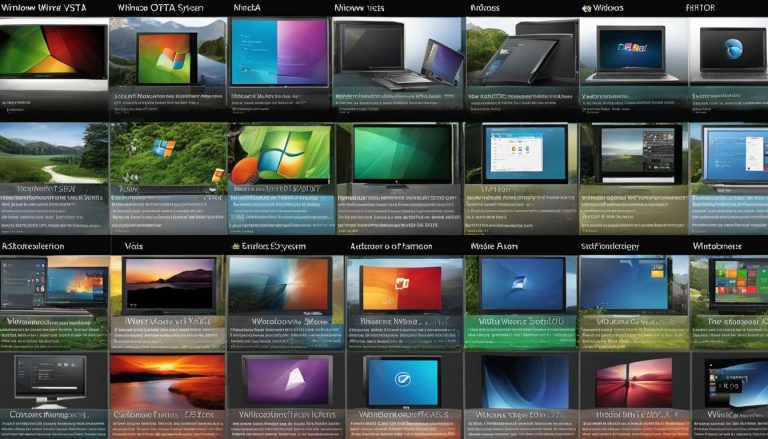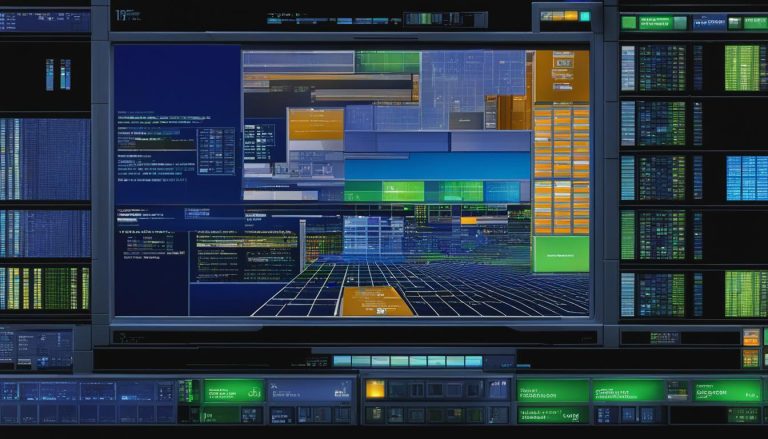As a journalist, I often find myself captivated by the ever-evolving world of technology. Today, I want to shed light on an operating system that has been making waves in the tech community – Windows 8. Whether you’re a seasoned tech enthusiast or simply someone curious about the latest advancements, join me as we explore the features and capabilities that make Windows 8 a game-changer.
Key Takeaways:
- Windows 8 is a versatile operating system with a unique user experience, designed for touch-enabled devices.
- The Metro interface offers a more intuitive and user-friendly interface, optimized for touchscreen interaction.
- Windows 8 introduces built-in apps for email, calendar, and contacts, as well as a wide range of downloadable apps from the Windows Store.
- Microsoft is committed to providing regular updates to address any issues and improve the overall user experience of Windows 8.
Windows 8 Versions and System Requirements
When it comes to Windows 8, there are two main versions: Windows 8 RT and Windows 8 Pro. Each version caters to different needs and offers unique features. Windows 8 RT is designed specifically for tablets and features a more streamlined interface. On the other hand, Windows 8 Pro is aimed at the corporate environment, providing advanced capabilities for businesses.
Let’s take a closer look at the system requirements for each version. For Windows 8 RT, the tablet version, you have the option of choosing between 32GB and 64GB of storage. The Windows 8 Pro version, on the other hand, offers more storage options with 64GB and 128GB. It’s important to consider the amount of storage you’ll need for your files and applications when deciding which version is right for you.
In addition to storage options, the two versions of Windows 8 also have different screen resolutions and thicknesses. These variations allow users to choose a device that suits their preferences and requirements. Whether you prioritize portability or screen quality, Windows 8 has options to accommodate your needs.
| Windows 8 Version | Storage Options | Screen Resolution | Thickness |
|---|---|---|---|
| Windows 8 RT | 32GB, 64GB | 1366 x 768 pixels | 9.3mm |
| Windows 8 Pro | 64GB, 128GB | 1920 x 1080 pixels | 13.5mm |
As you can see, Windows 8 offers flexibility in terms of storage, screen resolution, and thickness. This allows users to choose a device that aligns with their specific needs and preferences. Whether you’re looking for a tablet with ample storage or a high-resolution display, Windows 8 has options to suit your requirements.
The Unique Features of Windows 8
Windows 8 introduces several new features that set it apart from previous versions of the operating system. One of the most notable features is the Metro interface, which is optimized for touchscreen devices and offers a more intuitive and user-friendly experience. With its colorful tiles and customizable layout, the Metro interface provides quick access to apps, notifications, and important information.
Windows 8 also includes built-in apps for email, calendar, and contacts, making it easier than ever to stay connected and organized. These apps are designed to have a consistent look and feel across all devices, whether you’re using a tablet, laptop, or desktop computer. Additionally, the Windows Store allows users to download a wide range of apps, including games, productivity tools, and multimedia applications.
Another key feature of Windows 8 is its commitment to regular updates. Microsoft has made it a priority to listen to user feedback and address any issues or concerns through regular updates. These updates not only improve the overall performance and stability of the operating system but also introduce new features and enhancements. By keeping Windows 8 up to date, Microsoft ensures that users have the best possible experience with their devices.
“Windows 8 brings a fresh and modern approach to computing, with its intuitive Metro interface and built-in apps. The ability to customize the Start screen and have all my important information at a glance is a game-changer. Plus, the regular updates from Microsoft give me confidence that my device will continue to improve over time.”
Windows 8 Features:
- Metro interface optimized for touchscreens
- Built-in apps for email, calendar, and contacts
- Windows Store for downloading a wide range of apps
- Regular updates for improved performance and new features
In summary, Windows 8 introduces a range of unique features that enhance the user experience and make computing more intuitive and efficient. The Metro interface, built-in apps, and the Windows Store provide a seamless experience across devices, while regular updates ensure that users have access to the latest features and improvements.
| Windows 8 Features | Description |
|---|---|
| Metro interface | Optimized for touchscreens and offers quick access to apps and notifications |
| Built-in apps | Email, calendar, and contacts apps provide a consistent experience across devices |
| Windows Store | Allows users to download a wide range of apps for various needs |
| Regular updates | Improves performance, stability, and introduces new features |
Windows 8 Pricing and Support
When it comes to pricing, Microsoft has not yet released specific details for Windows 8. However, it is expected that the pricing will be competitive with other tablets and similar devices on the market. Microsoft has always aimed to offer affordable and accessible products, and Windows 8 is likely to follow this trend. Keep an eye out for official announcements from Microsoft regarding the pricing of Windows 8.
As for support, Microsoft has a range of resources available to assist users with any issues they may encounter while using Windows 8. One of the most valuable support options is the online support forums, where users can connect with other Windows 8 enthusiasts and experts to ask questions and troubleshoot problems. Additionally, Microsoft provides detailed documentation and guides that cover various aspects of Windows 8, offering step-by-step instructions and tips.
For those who prefer direct assistance, Microsoft also offers customer service through various channels. You can reach out to their support team via phone, email, or live chat to receive personalized support for your Windows 8-related queries. Whether you have questions about installation, compatibility, or general usage, Microsoft’s support team is there to help.
Overall, Microsoft understands the importance of providing comprehensive support to ensure a smooth and satisfactory user experience. With their range of support resources and customer service options, you can feel confident that assistance is readily available whenever you need it.
Table: Windows 8 Support Options
| Support Option | Description |
|---|---|
| Online Support Forums | Connect with other Windows 8 users and experts to get answers to your questions and troubleshoot issues. |
| Documentation and Guides | Access detailed documentation and step-by-step guides provided by Microsoft to assist with various aspects of Windows 8. |
| Customer Service | Reach out to Microsoft’s support team via phone, email, or live chat for personalized assistance with your Windows 8 queries. |
Installing and Compatibility of Windows 8
Installing Windows 8 is a straightforward process that can be done through a USB drive or DVD. Simply insert the installation media, boot from it, and follow the on-screen instructions. The installation wizard will guide you through the necessary steps, including selecting the installation type, partitioning the hard drive, and configuring basic settings.
Before proceeding with the installation, it is crucial to ensure that your device meets the minimum system requirements for Windows 8. These requirements include a compatible processor, a certain amount of RAM, and sufficient available storage space. It is recommended to check the official Microsoft website for the most up-to-date system requirements.
Compatibility can also be a concern when upgrading to Windows 8, especially if you have older hardware or software. To address this, Microsoft provides a compatibility checker tool that can help identify any potential issues before proceeding with the installation. The compatibility checker scans your system for hardware and software compatibility, providing you with a detailed report of any potential conflicts or incompatibilities.
Table: Windows 8 System Requirements
| Minimum Requirements | Recommended Requirements |
|---|---|
| Processor: 1 GHz or faster with support for PAE, NX, and SSE2 | Processor: 2 GHz or faster with support for PAE, NX, and SSE2 |
| RAM: 1 GB (32-bit) or 2 GB (64-bit) | RAM: 4 GB or more |
| Storage: 16 GB (32-bit) or 20 GB (64-bit) | Storage: 40 GB or more |
| Graphics card: DirectX 9 or later with WDDM 1.0 driver | Graphics card: DirectX 10 or later with WDDM 1.0 driver |
| Display: 800×600 resolution | Display: 1024×768 resolution or higher |
Ensuring compatibility before upgrading to Windows 8 can help prevent any performance issues or system instability. It is always recommended to backup your important files and create a system restore point before proceeding with any major operating system updates.
Conclusion
In my review of Windows 8, I must say that it is a versatile operating system that offers a unique user experience, especially on touch-enabled devices. With its Metro interface and intuitive features, Windows 8 introduces a fresh and modern approach to computing.
Microsoft has shown a commitment to providing support for Windows 8, ensuring that users have access to various resources to address any issues they may encounter. From online support forums to comprehensive documentation, Microsoft has made efforts to assist users in navigating the new operating system.
Before installing Windows 8, it is crucial to check the compatibility of your device. Using Microsoft’s compatibility checker tool can help identify potential issues and ensure a smooth transition to Windows 8.
All in all, Windows 8 is an exciting and innovative addition to the world of operating systems. With its unique features, ongoing support, and emphasis on compatibility, Windows 8 is poised to make a significant impact in the digital landscape.
FAQ
What is Windows 8?
Windows 8 is the latest operating system developed by Microsoft. It offers a unique user experience and introduces new features and improvements over previous versions of Windows.
What are the different versions of Windows 8 and their system requirements?
There are two main versions of Windows 8: Windows 8 RT and Windows 8 Pro. Windows 8 RT is designed for tablets and has a more limited feature set. Windows 8 Pro is aimed at the corporate environment and offers more advanced features. The system requirements differ for each version.
What are the unique features of Windows 8?
Windows 8 introduces several new features, including the Metro interface which is optimized for touch-enabled devices, built-in apps for email, calendar, and contacts, and the ability to download apps from the Windows Store. Microsoft also promises regular updates to address any issues and improve the overall user experience.
How much does Windows 8 cost and what support is available?
The pricing details for Windows 8 have not been announced yet, but Microsoft aims to be competitive with other tablets and similar devices on the market. For support, Microsoft offers various resources such as online support forums, documentation, and customer service to assist users with any issues they may encounter while using Windows 8.
How do I install Windows 8 and check compatibility?
Installing Windows 8 is a straightforward process that can be done through a USB drive or DVD. Before installing, it is important to check if your device meets the minimum system requirements for Windows 8. Microsoft provides a compatibility checker tool that can help identify any potential issues before upgrading to Windows 8.
Janina is a senior specialist in information technology


